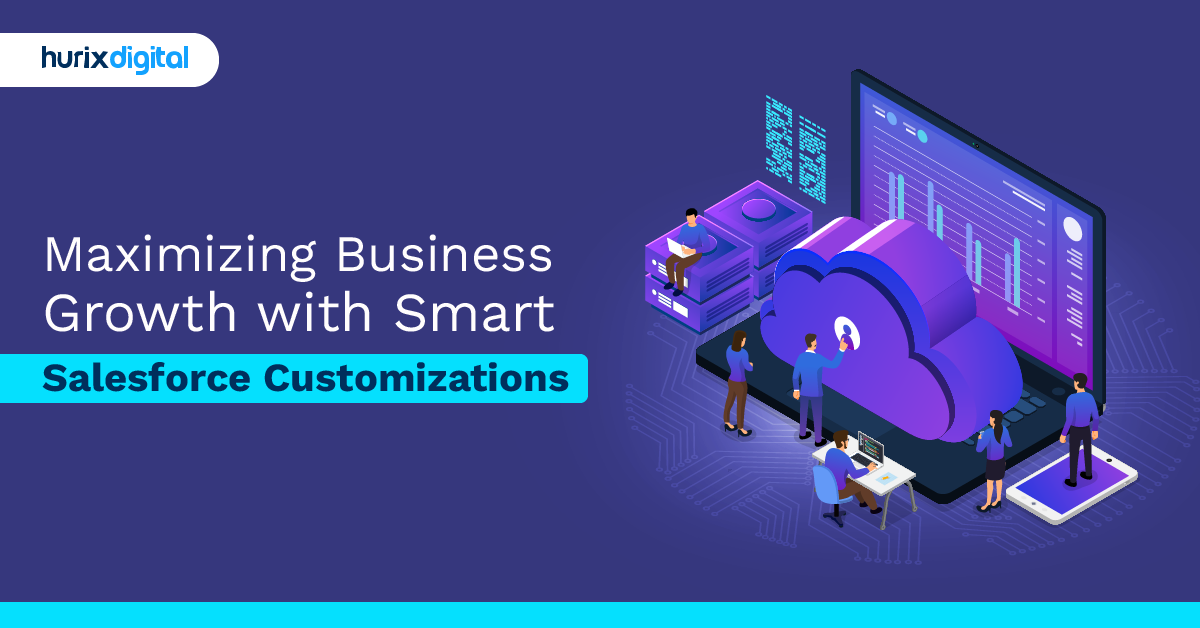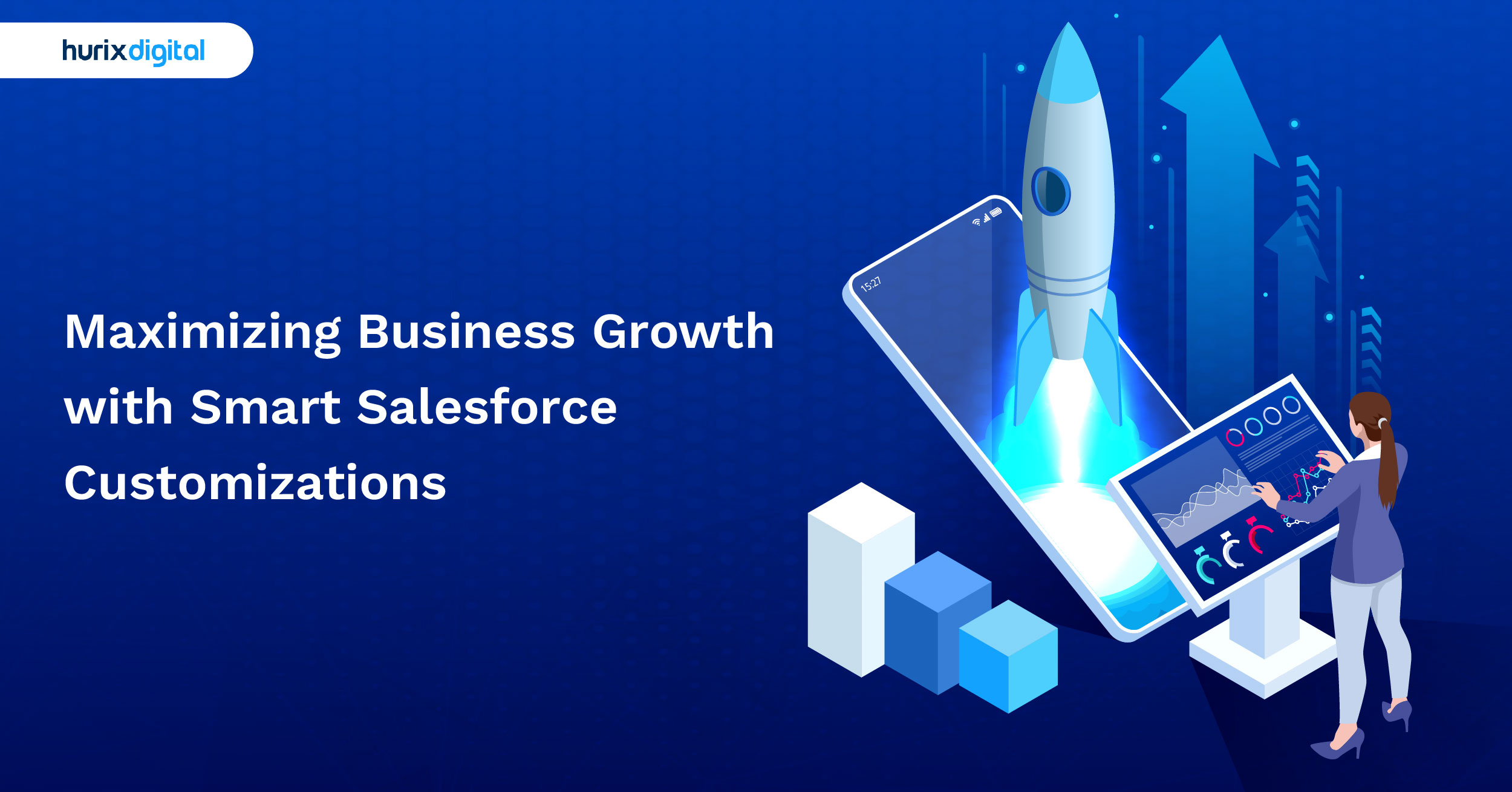
Optimizing Business Efficiency with Salesforce Integration Services
Summarize with:
Efficient IT resource management is essential for businesses aiming to gain a competitive edge. Salesforce Integrations play a crucial role in enhancing IT efficiency and reducing workloads.
According to a Salesforce report, companies utilizing Salesforce automation observed a 34% increase in productivity. These integrations streamline operations, enabling IT departments to focus more on strategic initiatives rather than daily maintenance tasks.
Studies show that companies adopting this integration have seen significant improvements, including a 44% boost in data completeness, a 37% increase in sales productivity, and a 29% rise in sales opportunities. These metrics underscore the substantial impact that effective integration can have on a company’s performance.
Ultimately, when Salesforce is seamlessly integrated with other business systems, it transcends its role as merely a CRM. It becomes a powerful engine for growth and innovation, driving operational excellence and strategic advancements.
With cloud-based solutions, Salesforce Integrations also significantly cut IT costs and expand IT staff capacity, making operations more scalable and efficient. This transformation through Salesforce optimizes IT processes and drives substantial business growth.
Table of Contents:
- Understanding Salesforce Integrations
- How Salesforce Integrations Reduce IT Workload?
- How Can Salesforce Integration Services Propel Your Business to New Heights?
- Exploring Best Salesforce Automation Practices
- Case Studies: Successful IT Integration Solutions
- Choosing the Best Salesforce Consulting Services
- Trends in Salesforce Integrations
- The Future of Salesforce Integration
- Top 3 Ways to Enhance the Value of Salesforce Integration
- Wrapping Up
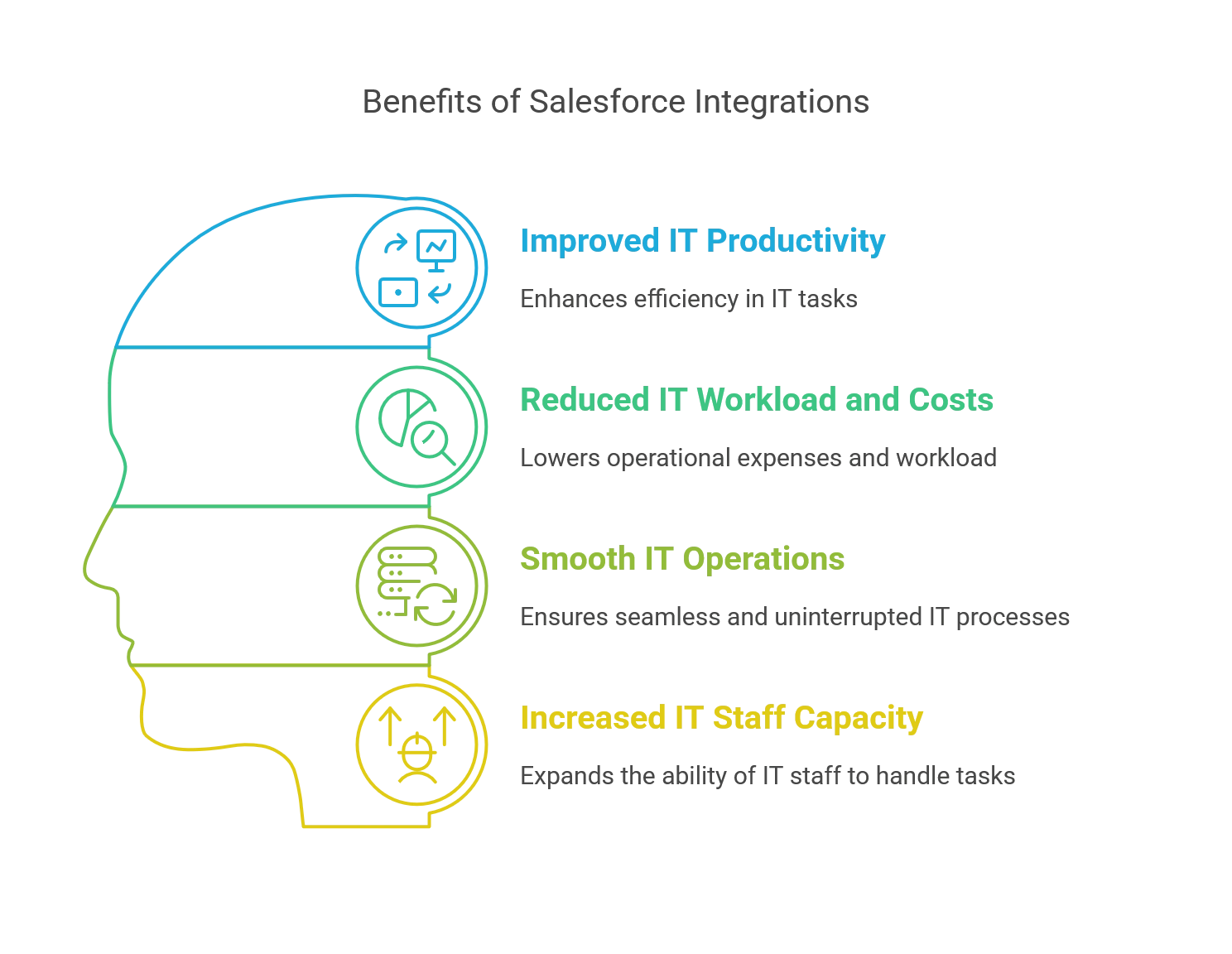
Understanding Salesforce Integrations
Salesforce Integrations involve connecting the Salesforce Customer Relationship Management platform with other business systems to streamline data exchange and automate workflows.
The integration will be crucial in maximizing IT efficiency and minimizing the complications of operations in the following aspects:
1. Improved IT Productivity
Salesforce Integration will automate repetitive tasks, saving IT staff time to work on more strategic projects. A study has shown that organizations using Salesforce automation resulted in a 26% increase in IT productivity. This shift increases workers’ efficiency and improves employee satisfaction by letting them do meaningful and impactful work.
2. Reduced IT Workload and Costs
Salesforce Integration reduces the need for manual data entry and maintenance, bringing down an organization’s operational costs. Companies using Salesforce have reported a 25% reduction in IT spending. This allows businesses to reallocate funds to more important causes like innovation or expanding markets.
3. Smooth IT Operations
Salesforce Integration simplifies complex processes, ensuring data flows seamlessly between systems. It makes operations very smooth, with one report noting a 30% improvement in operational efficiency among Salesforce users.
These streamlined processes relieve IT pressure and enable people to adapt more quickly to new challenges and changes in the business environment.
4. Increased IT Staff Capacity
Salesforce automates routine tasks, allowing IT staff to contribute significantly to innovation. This shift enables companies to focus more on creating rather than maintaining. As a result, there is increased innovation and better competitiveness through excellent service and technology.
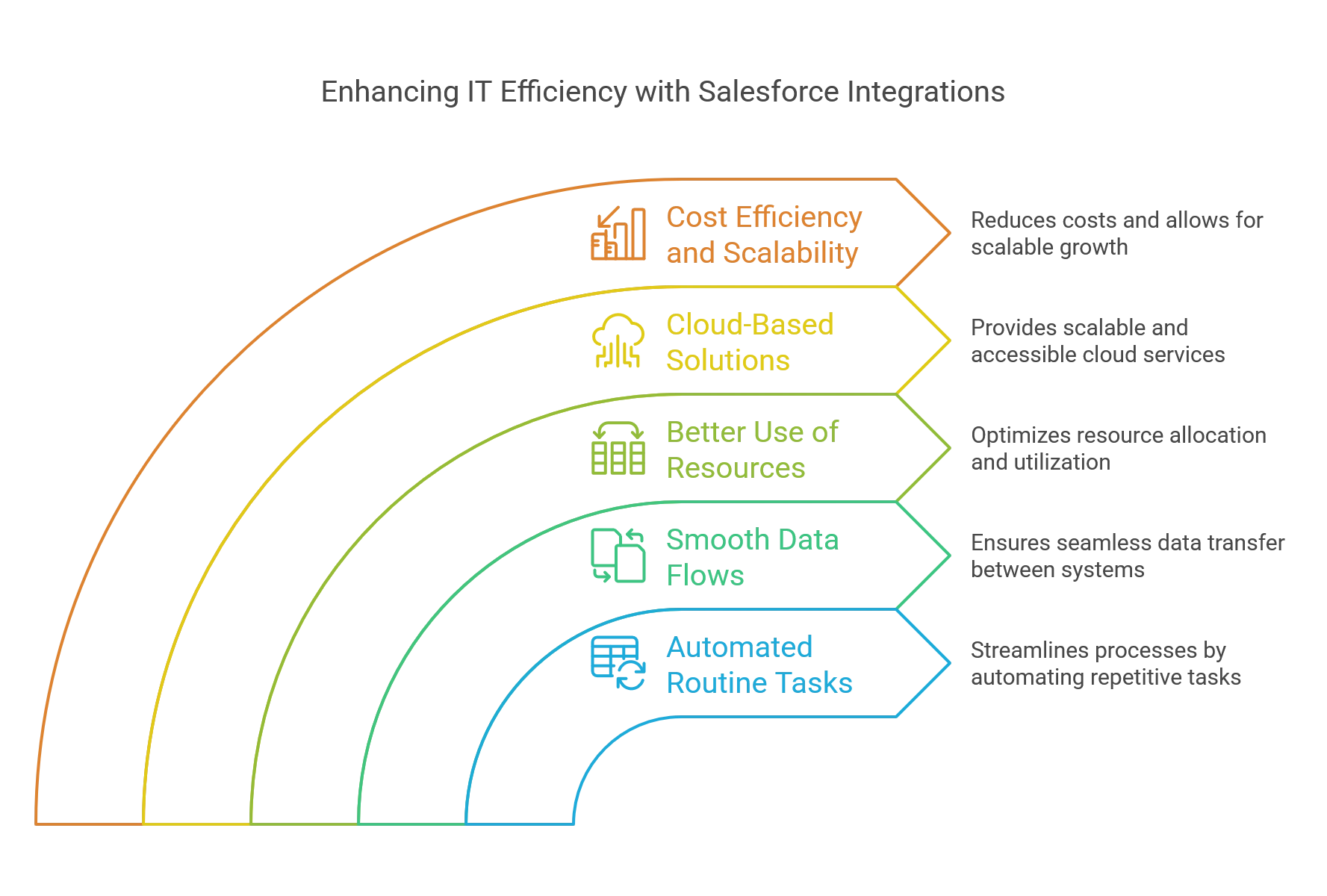
How Salesforce Integrations Reduce IT Workload?
Salesforce Integrations lighten the IT workload by automating complex processes and enhancing system interoperability. This streamlined approach improves efficiency and optimizes resource allocation across IT departments.
Here’s how Salesforce achieves this:
1. Automated Routine Tasks
Automating day-to-day operations like data entry, customer queries, and administrative reports enables IT staff to focus on more strategic and impactful projects. This reduces instances of human error, ensures greater consistency in data management, and further reduces the burden on IT personnel.
2. Smooth Data Flows
Salesforce Integrations’ potential makes it possible to easily interact with diverse software systems and applications, whether CRM tools or ERP systems. The integration allows the flow of synchronized data across all platforms, eliminating the necessity for manual data matching, which cuts the IT workload.
3. Better Use of Resources
With core functions automated and smooth data integration possible, IT departments can better allocate their scarce resources. They can initiate innovative and improvement projects. This change increases efficiency and empowers IT teams to be more involved in the growth of the business.
4. Cloud-Based Solutions
Since Salesforce’s environment is in the cloud, less on-premise hardware requires maintenance, traditionally consuming a vast share of IT resources. Cloud-based integrations reduce pressure on IT staff by minimizing the need for hardware setup, maintenance, and updates.
5. Cost Efficiency and Scalability
Integrations through Salesforce can lead to cost savings by optimizing operations and reducing the need for additional staffing as businesses scale. The flexibility of Salesforce Integrations accommodates business growth without proportionally increasing the IT workload, thus maintaining efficiency.
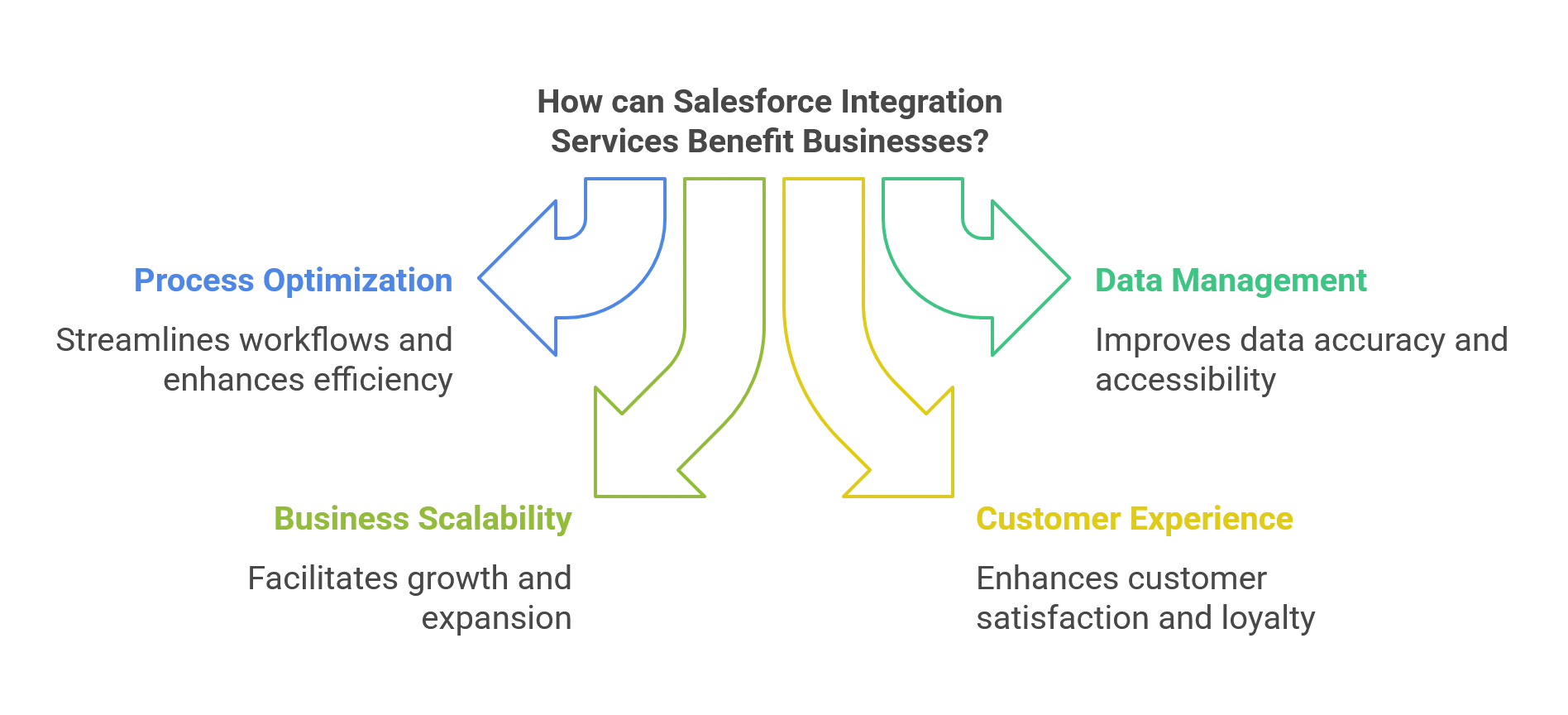
How Can Salesforce Integration Services Propel Your Business to New Heights?
Here’s how seamless Salesforce integration can elevate how your organization functions:
1. Process Optimization
Business process optimization is at the top of all CIOs and CTOs’ to-do lists. Seamless Salesforce integration ensures that business processes are productive and headed in the right strategic direction.
Here’s how:
- Streamlined Workflows: Using Salesforce alongside other systems helps save time on repetitive tasks such as lead generation and order processing. For instance, integration between Salesforce and marketing automation tools can accelerate the flow from marketing to sales.
- Improved Efficiency: Business process automation eliminates manual intervention, thereby lessening the chances of errors. Automated data synchronization across systems allows your team to concentrate on value-critical tasks instead of inputting data manually.
- Enhanced Collaboration: Integrated systems ensure that information can be passed freely among various departments within the firm. A single data view gives all stakeholders the most up-to-date data to work with. This eliminates duplication and errors, leading to efficient teamwork.
2. Data Management
Businesses recognize the importance of effective data management in staying competitive and agile.
Here’s how Salesforce API integrations can transform the way businesses handle their data:
- Breaking Down Data Silos: Integration solves the issue of isolated data pockets by linking Salesforce with ERP, marketing, and customer support systems. It establishes a unified data source available for all departments. This helps departments make accurate and timely decisions on matters affecting the organization.
- Automated Data Synchronization: Integration automates data updates across different platforms, ensuring data consistency and accuracy. This makes the process less error-prone and saves time for more important tasks.
- Data Quality Improvement: Integration enables data cleansing and enrichment to augment data completeness and validity. This can be beneficial in data analysis, resulting in better decisions and improved ROI from Salesforce investments.
3. Business Scalability
Salesforce Integration Services are fundamental for companies seeking to grow and innovate. Here’s how they can help businesses scale faster and sustainably:
- Expanding Capabilities: As your firm grows, the need for sophisticated features increases. Integrating new applications with Salesforce enhances its capabilities, enabling it to fulfill changing customer requirements.
- Supporting Business Growth: As data volumes grow and user activity increases, top cloud-based integrations help Salesforce handle the load without performance problems. This means that the business can scale seamlessly.
- Enabling Innovation: Integration services allow businesses to try out new technologies, such as artificial intelligence (AI) or the Internet of Things (IoT). This drives growth while also ensuring that companies remain ahead of the competition.
4. Customer Experience
In a highly competitive environment, offering an excellent customer experience is key.
Here are some ways that seamless Salesforce integration can assist businesses in providing personalized journeys and improving service standards:
- 360-degree Customer View: Integration combines information from different sources into one place, thus giving a complete picture of the target buyer’s preferences and behaviors. This allows firms to anticipate needs and customize engagements accordingly.
- Personalized Customer Journeys: With digital marketing and service platforms connected to Salesforce, companies can deliver tailored solutions ranging from advertising and sales promotions to customer care services.
- Improved Customer Service: Integrated systems enable faster, more effective customer support with real-time access to relevant information. This leads to faster resolution times, increased satisfaction rates, and higher customer loyalty levels.
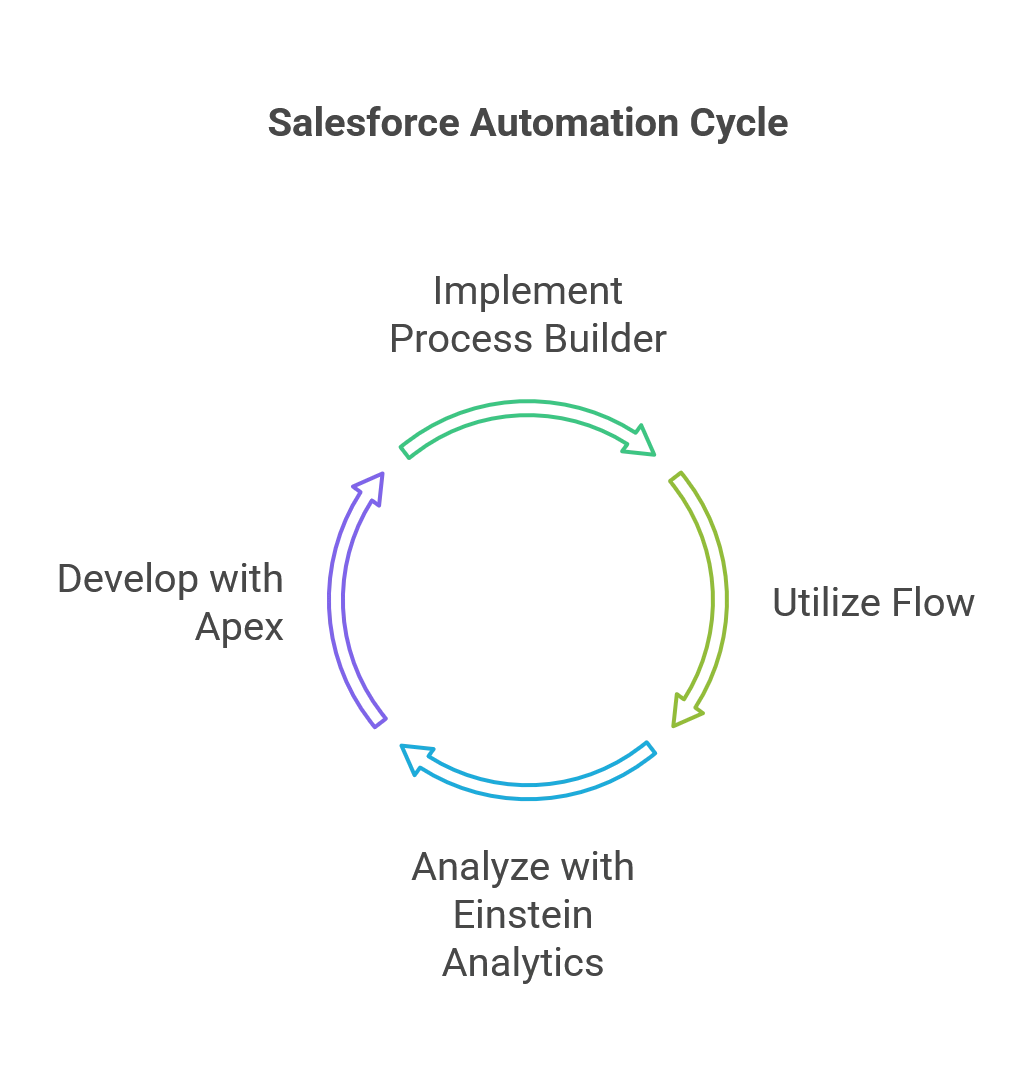
Exploring Best Salesforce Automation Practices
Salesforce automation is instrumental in enhancing IT efficiency, primarily by reducing manual workloads and optimizing system operations. Below is a look at some of the top automation tools and techniques within Salesforce that are pivotal in improving IT operations:
1. Process Builder and Workflow Rules
These tools allow IT teams to automate complex business processes easily. By setting up auto-responses, field updates, and record creations, teams can reduce manual input and streamline day-to-day tasks.
2. Flow
Salesforce’s Flow enables more advanced automation capabilities than Workflow. It can handle complex logical decisions, making it ideal for automating intricate processes that depend on multiple variables. This tool increases IT productivity by managing processes and minimizing manual intervention requirements.
3. Einstein Analytics
This AI-powered tool helps automate data analysis and generate actionable insights, which can drastically improve decision-making processes and operational efficiency. Additionally, Einstein Analytics can predict trends and behavior patterns, allowing organizations to adjust their strategies and operations for better outcomes proactively.
4. Apex
For custom automation solutions, the Apex programming language offers a way to write code that executes on the Salesforce platform. This automates tasks that are not covered by standard automation tools.
Apex is perfect for developing complex business logic within Salesforce applications, which enhances IT productivity.

Case Studies: Successful IT Integration Solutions
Salesforce Integrations have delivered impactful improvements in IT operations across various industries. Here are two documented examples that showcase their effectiveness:
1. Aston Martin
Aston Martin integrated Salesforce to enhance their customer management and marketing operations. The integration allowed for more personalized customer interactions and streamlined communication between departments.
According to Salesforce, this resulted in improved customer service efficiency and increased sales opportunities through better data insights and management.
2. KONE
Elevator and escalator manufacturer KONE uses Salesforce to unify their customer service operations across multiple channels. This integration facilitated more efficient case handling and faster response times by giving service agents complete access to customer information in one place.
Salesforce reports that, as a result, KONE achieved a notable decrease in response times and higher customer satisfaction ratings.
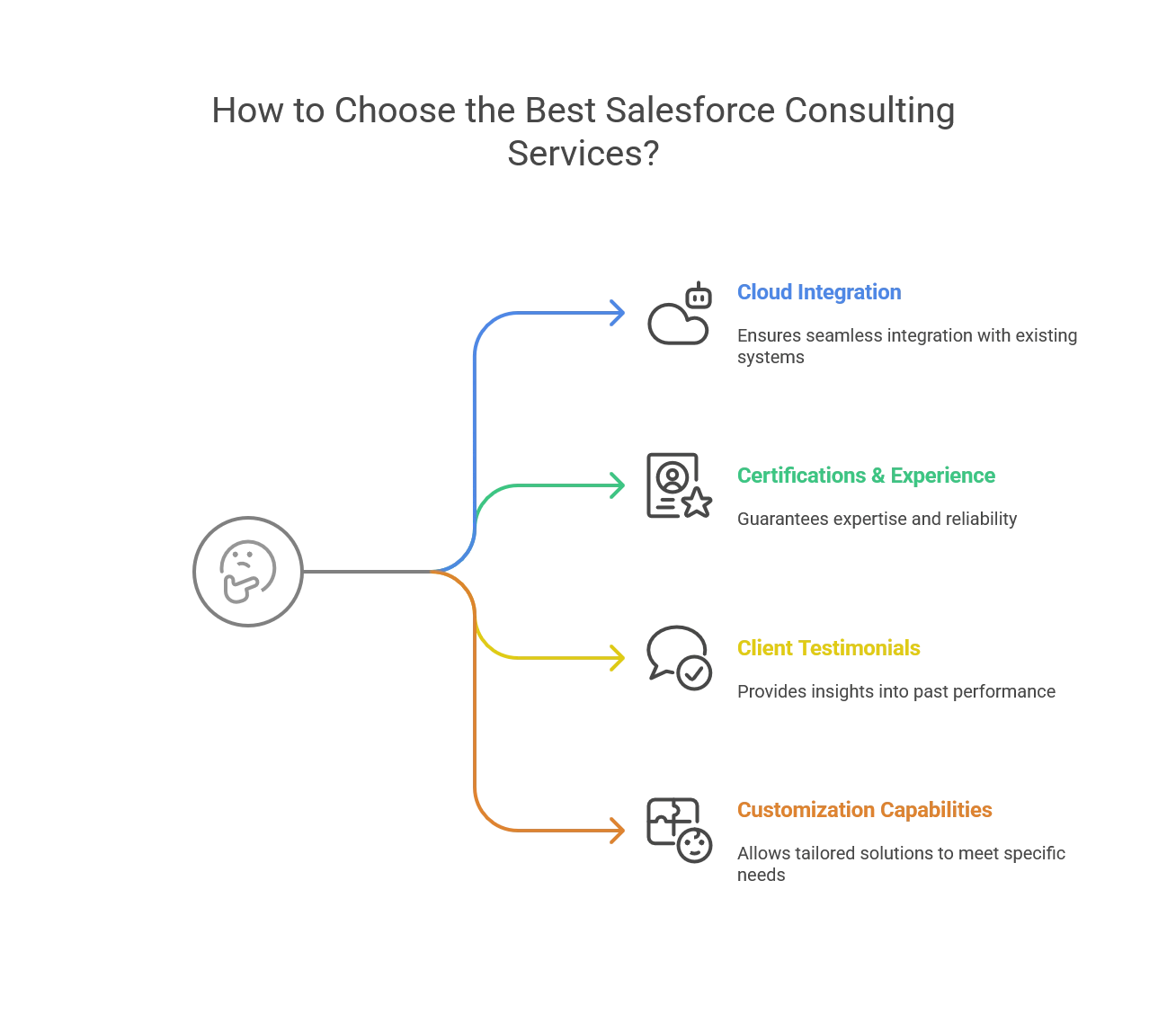
Choosing the Best Salesforce Consulting Services
Selecting the right Salesforce consulting service is important to get the full benefits of Salesforce Integrations. Here are key tips that will ensure you align with a consultant to suit your IT requirements:
1. Look for Cloud-Based Integration Experts
Make sure your consultants can demonstrate previous experience in cloud-based solutions. With cloud integration prowess, experts can use Salesforce to its fullest capacity and easily integrate it with other cloud applications to boost scalability and flexibility.
2. Ensure Certifications and Experience
The consulting service should have relevant Salesforce certifications. Certifications indicate experience and how seriously the service takes learning to keep up with Salesforce’s new features.
3. Check Out Client Testimonials and Case Studies
Many testimonials and case studies show how the consultant achieves successful outcomes. Successful integration projects should demonstrate competence in reducing IT costs and streamlining operations.
4. Explore Customization Capabilities
Choose a consultant who can customize Salesforce solutions to suit your specific business requirements. Tailored integrations will increase the effectiveness and efficiency of IT operations.
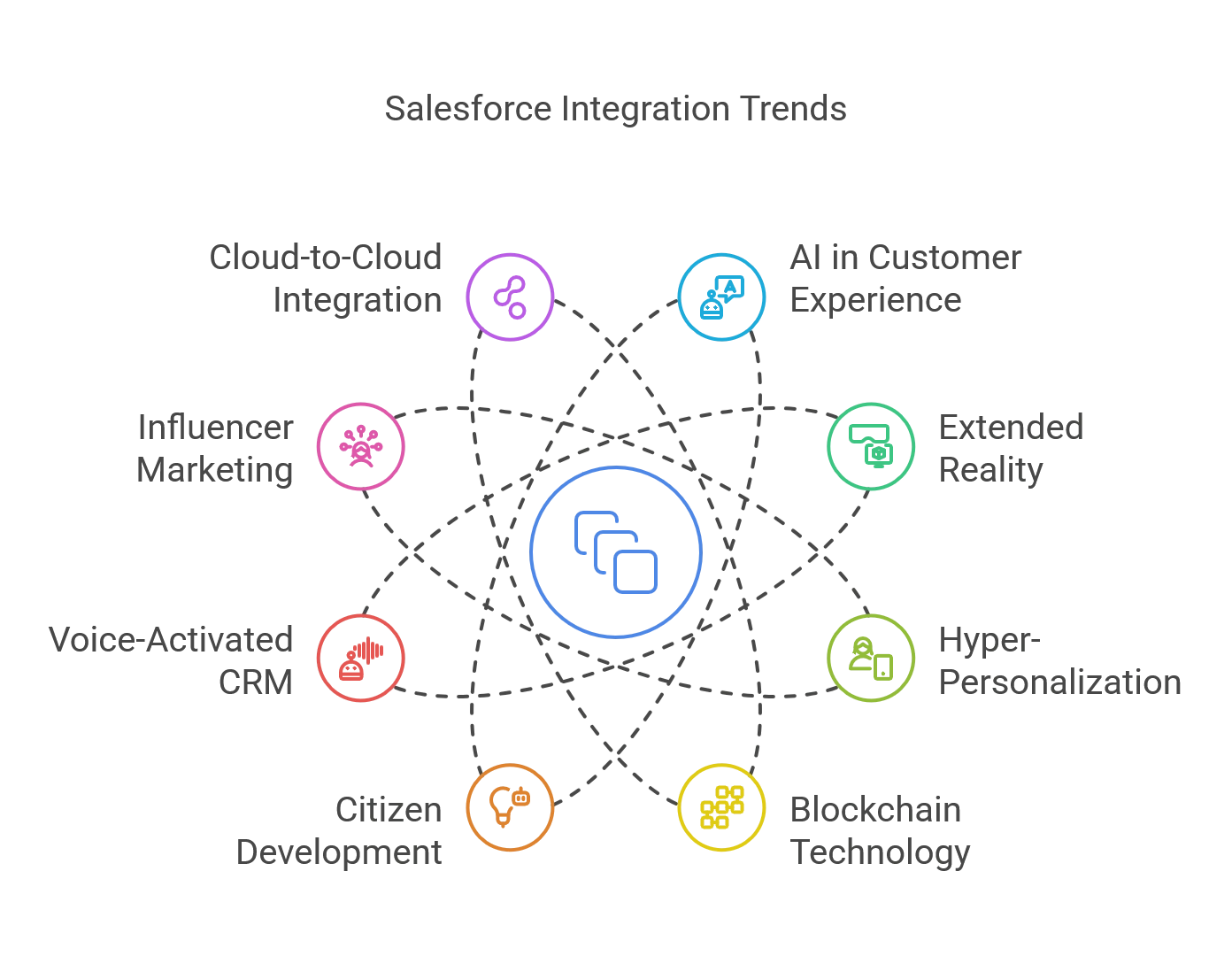
Trends in Salesforce Integrations
Let us explore the top Salesforce Integrations that deliver significant value to businesses. Identifying and prioritizing these effective integrations is crucial for maximizing the return on Salesforce investment.
1. Redefining Customer Experience with AI
Salesforce’s inclusion of generative AI has marked a significant turning point in the development of CRM technology. IT executives must exercise strategic leadership to transform the CRM landscape as AI develops and becomes increasingly sophisticated and integrated within Salesforce.
This convergence empowers businesses to harness AI’s power to automate routine tasks, deliver hyper-personalized experiences, and uncover actionable insights from vast datasets. By automating mundane processes, AI frees human resources to focus on higher-value activities, driving productivity and efficiency.
Moreover, AI-driven predictive analytics enable organizations to anticipate customer needs and take preemptive action on possible issues. This proactive approach facilitates stronger customer relationships and improves overall satisfaction.
Predicting customer behavior and addressing needs proactively is a game-changer for organizations, enabling them to stay ahead of the curve. CIOs and CTOs must acknowledge the connection between AI and CRM to help their company provide high value in all customer interactions.
2. The Emergence of Extended Reality
Integrating Augmented Reality (AR) into Salesforce marks a new era in field service activities. AR allows employees to boost efficiency, reduce downtime, and enhance customer satisfaction through interactive resources and real-time visual instruction.
Extended Reality (XR), encompassing both Augmented Reality (AR) and Virtual Reality (VR), holds immense potential to rethink CRM tactics. From training and product demonstrations to virtual inspections and remote assistance, XR offers tremendous potential for transforming customer interactions.
The extended reality (XR) market is poised for explosive growth, with projections indicating a valuation of USD 1,706.96 billion by 2032. Organizations now use XR for a competitive advantage in integrations, driven by an astounding CAGR of 32.1%.
Its Salesforce integration will also become easier to use. To capitalize on the benefits of this emergent technology, CIOs and CTOs need to monitor XR trends closely. By carefully integrating XR into Salesforce, organizations may reimagine customer engagement and drive operational excellence.
3. Hyper-Personalization
Hyper-personalization is the pinnacle of the customer experience, offering customized encounters that deeply connect with personal preferences. With artificial intelligence and advanced analytics, businesses may supply dynamic content, anticipate client requirements, and cultivate long-term loyalty.
Salesforce’s AI-driven capabilities demonstrate the company’s commitment to this paradigm shift by allowing businesses to develop tailored client journeys. This shift in client experiences from generic to hyper-personalized is supported by a deep understanding of their behavior and preferences.
4. Blockchain Technology
Strong security measures are essential since cyber threats are always changing. Blockchain technology offers an unbreakable barrier of immutability that protects sensitive consumer data from data breaches.
Salesforce’s incorporation of blockchain technology represents a major improvement in CRM security and transparency. Because blockchain technology is immutable and decentralized, Salesforce can provide improved data protection, secure transaction records, and verifiable customer IDs.
Salesforce can cultivate trust and strengthen its client connections by creating an auditable, transparent record of transactions. The revolutionary potential of blockchain technology and its role in safeguarding CRM going forward are imperative recognitions for CIOs and CTOs.
5. The Rise of Citizen Development
The rise of no-code and low-code development platforms in the Salesforce ecosystem represents a major change in app development. These platforms enable non-expert coders to design personalized solutions, making development more accessible and speeding up product launch times.
Citizen developers can quickly create customized applications for business requirements using user-friendly drag-and-drop interfaces and ready-made components. Promoting development and democratization encourages innovation, agility, and improved business efficiency.
CIOs and CTOs must acknowledge citizen development’s capabilities in boosting business growth and improving operational efficiency. Organizations can utilize citizen developers’ potential by giving them tools and guidance while overseeing development.
6. Voice-Activated CRM
Salesforce integrations of voice technology represent a major improvement in the CRM user experience. CIOs and CTOs must understand how voice-activated CRM may improve customer satisfaction and staff productivity.
Salesforce is leading the way in a new era of hands-free productivity by providing voice-driven data entry, search, and analytics interactions. This move to voice-activated CRM aligns with general industry trends and demonstrates the rising need for simple, readily available user interfaces.
As voice technology advances, we may anticipate more advanced features like real-time transcription, natural language processing, and sophisticated speech recognition.
7. Influencer Marketing
Salesforce’s deliberate emphasis on influencer marketing highlights the platform’s dedication to providing all-inclusive solutions for customer engagement. CIOs and CTOs need to understand how influencer marketing may propel company expansion and think about how Salesforce can be used to optimize its effects.
Organizations may establish strong brand affinity and produce high-quality leads by coordinating influencer marketing efforts with more comprehensive CRM initiatives and enabling businesses to find, collaborate with, and assess influencers’ impact.
Influencer marketing’s incorporation into the CRM ecosystem presents a potent chance to target particular audience segments and enhance campaign performance.
8. Cloud-to-Cloud Integration
Salesforce Integrations with other cloud-based apps are becoming more common as cloud adoption quickens. The cloud-to-cloud connection is becoming increasingly important strategically for businesses to utilize their cloud investments fully.
With public cloud infrastructure, businesses can easily grow internationally while maintaining data residency and local law compliance. This method improves scalability, performance, and security, allowing companies to take advantage of new market opportunities and provide outstanding client experiences globally.
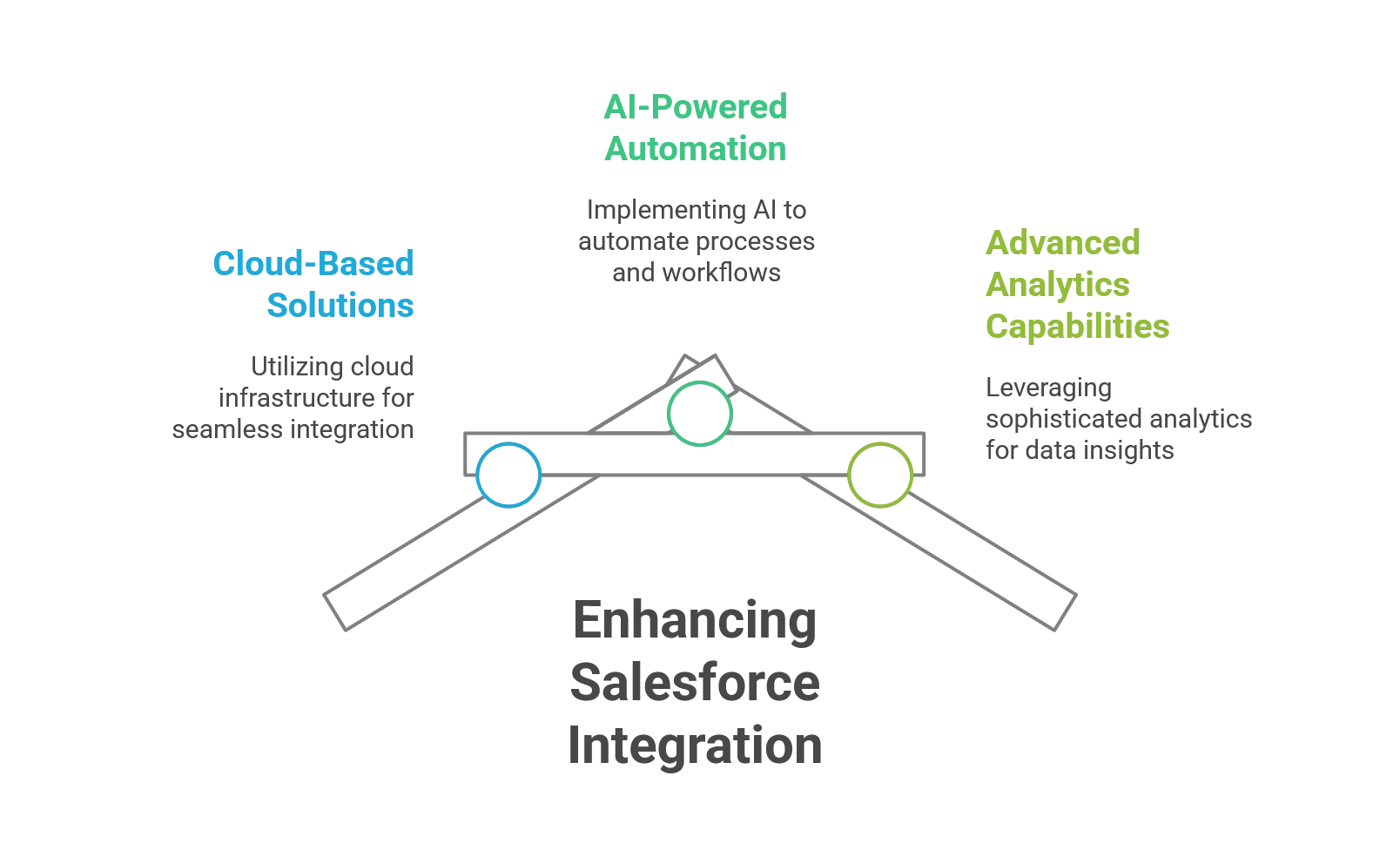
The Future of Salesforce Integration
As technology advances, Salesforce integration services will continue to evolve, with cloud-based solutions taking the lead. The future of integration is bright, given the emerging technologies that will change how we work:
1. Cloud-Based Solutions
These platforms provide the scalability and flexibility to connect systems across a variety of environments. This eases management and speeds up the transition towards greater digitalization.
2. AI-Powered Automation
AI facilitates integration by automating data processing and other intricate operations. This leads to the creation of predictive models that let businesses make anticipatory decisions to provide an optimal customer experience.
3. Advanced Analytics Capabilities
Integrating Salesforce with analytics platforms provides more meaningful metrics on business outcomes and customer trends. This informs strategic processes and constant enhancements throughout the organization.

Top 3 Ways to Enhance the Value of Salesforce Integration
With the emergence of new integration technologies, the significance of Salesforce integration will increase further.
To maximize Salesforce integration benefits, businesses should focus on the following:
1. Accelerated Time-to-Value
Cloud technology integration is relatively fast and can be scaled to suit a company’s needs. This allows companies to start reaping the advantages of unified data usage immediately.
2. Enhanced Intelligence
With the integration of AI, businesses stand to benefit from advanced predictive analytics and customized recommendation services. This improves the organization’s decision-making capabilities and overall business intelligence.
3. Improved Business Agility
Advanced analytics from integrated systems enable businesses to swiftly adapt to changing market conditions. This increased agility allows organizations to stay ahead of the competition and maintain market leadership through continuous innovation and responsiveness to new opportunities.
Wrapping Up
Seamless Salesforce integration is the future of business, as it fosters agility and intelligence. Cloud-based solutions and AI can help companies to enhance the Salesforce platform’s capabilities, helping them stay ahead of the game in a data-intensive environment.
At Hurix Digital, we provide the best Salesforce consulting services to help you achieve higher productivity levels. Our solutions effectively address your business needs while maintaining compatibility between essential systems. Partner with us to improve your business agility and the overall value of your Salesforce solution.
Contact us today to learn more about how we can help you drive growth and success!
Summarize with:

Vice President & SBU Head –
Delivery at Hurix Technology, based in Mumbai. With extensive experience leading delivery and technology teams, he excels at scaling operations, optimizing workflows, and ensuring top-tier service quality. Ravi drives cross-functional collaboration to deliver robust digital learning solutions and client satisfaction
 Upcoming Masterclass | Build an Army of Brand Evangelists using Training & Development | November 20th, 8:30 AM PDT | 11:30 AM EDT | 10:00 PM IST
Upcoming Masterclass | Build an Army of Brand Evangelists using Training & Development | November 20th, 8:30 AM PDT | 11:30 AM EDT | 10:00 PM IST




